High Level Summary of Statistics: Key Trends for Scotland 2006
Presents key trends for Scotland across all areas of governement activity.
3. Labour Market
Employment and Economic Activity
Economic Activity
Scotland's labour market has been performing well in recent years, with more individuals in employment than ever before. Both the employment rate and the economic activity rate (those in employment or seeking employment) are at historically high levels. The employment rate for the period Jan-Mar 2006 stood at 75.3%, with the economic activity rate at 79.6%. The employment rate has increased by around 4 percentage points since 1999 with almost 180,000 more people in employment than in 1999.
Currently Scotland is fifth highest out of the 12 UK regions in terms of employment rates and fourth in terms of economic activity rates. Moreover Scotland has higher economic activity and employment rates than England, Wales, Northern Ireland and the UK as a whole.
The latest data show that Scotland has an unemployment rate of 5.3%. This is a reduction of 2 percentage points since 1999. Scotland has the third highest unemployment rate out of the 12 UK regions.
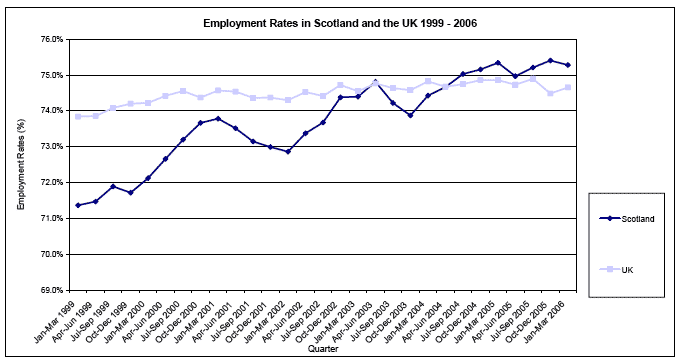
Source: Labour Force Survey, Office for National Statistics
Publication
Labour Market Statistics Scotland Office for National Statistics (Published 2006)
Local Labour Markets
The number of working age people in employment, education or training ( EET) in Scotland was estimated to be 2.483 million in 2004. That was 79.4% of the working age people in Scotland, an increase of 1.2 percentage points on 2003. This varies considerably between the different Local Authorities. Glasgow and Inverclyde had the lowest EET proportions in 2004, at 71.1% and 73.7% respectively. Whereas, at the upper end, five areas had EET proportions above 85.0% in 2004: Shetland Islands (87.2%), Orkney Islands (86.7%), East Dunbartonshire (86.2%), Highland (85.9%) and East Renfrewshire (85.9%). The majority of Local Authorities saw an increase in the proportion of working age people in employment, education or training between 2003 and 2004.
Employment, Education or training ( EET) rates
Resident Local Authority Area |
2003 |
2004 |
|
|---|---|---|---|
Proportion |
Proportion |
Number of people |
|
Scotland |
78.2% |
79.4% |
2,483,000 |
Aberdeen City |
82.3% |
82.6% |
108,000 |
Aberdeenshire |
83.3% |
83.8% |
119,000 |
Angus |
78.5% |
80.7% |
52,000 |
Argyll & Bute |
80.0% |
80.3% |
42,000 |
Scottish Borders, The |
82.5% |
83.7% |
53,000 |
Clackmannanshire |
75.8% |
76.9% |
22,000 |
West Dunbartonshire |
74.2% |
75.7% |
43,000 |
Dumfries and Galloway |
80.2% |
81.3% |
68,000 |
Dundee City |
76.7% |
76.2% |
64,000 |
East Ayrshire |
74.2% |
76.0% |
55,000 |
East Dunbartonshire |
84.1% |
86.2% |
57,000 |
East Lothian |
79.6% |
81.3% |
46,000 |
East Renfrewshire |
84.7% |
85.9% |
48,000 |
Edinburgh, City of |
81.9% |
84.0% |
247,000 |
Falkirk |
78.9% |
79.5% |
72,000 |
Fife |
80.0% |
80.8% |
175,000 |
Glasgow City |
71.1% |
71.1% |
264,000 |
Highland |
83.4% |
85.9% |
106,000 |
Inverclyde |
73.5% |
73.7% |
37,000 |
Midlothian |
79.6% |
84.3% |
43,000 |
Moray |
82.0% |
81.3% |
41,000 |
North Ayrshire |
72.0% |
73.6% |
60,000 |
North Lanarkshire |
70.3% |
74.4% |
149,000 |
Orkney Islands |
86.6% |
86.7% |
10,000 |
Perth and Kinross |
82.1% |
81.9% |
64,000 |
Renfrewshire |
78.1% |
78.2% |
82,000 |
Shetland Islands |
88.2% |
87.2% |
11,000 |
South Ayrshire |
77.1% |
79.1% |
52,000 |
South Lanarkshire |
77.0% |
78.3% |
148,000 |
Stirling |
80.1% |
80.3% |
43,000 |
West Lothian |
80.1% |
81.9% |
88,000 |
Eilean Siar (Western Isles) |
86.6% |
84.0% |
12,000 |
Source: Annual Scottish Labour Force Survey 2004/05
Publication
Annual Scottish Labour Force Survey 2004/05 (Published 2005)
Public Sector Employment
As at Quarter 4 (Q4) 2005 there were 580,300 people employed within the public sector in Scotland. This was an increase of 6,200 since the previous year and an increase of 50,200 since 1999. In Q4 2005 the number of people employed in the private sector was 1,880,700. This is an increase of 3,800 on the previous year and an increase of 104,800 since 1999. Public sector employment accounted for 23.6% of total employment in Q4 2005 which is up by 0.2 percentage points since previous year and 0.6 percentage points since 1999.
In Q4 2005 Public sector employment in Scotland consisted of Local Government including police and fire and related services (55.5%), NHS (25.7%), Civil Service (8.9%), Public Corporations (5.1%), Non Departmental Public Bodies (2.1%) and Armed Forces (2.3%).
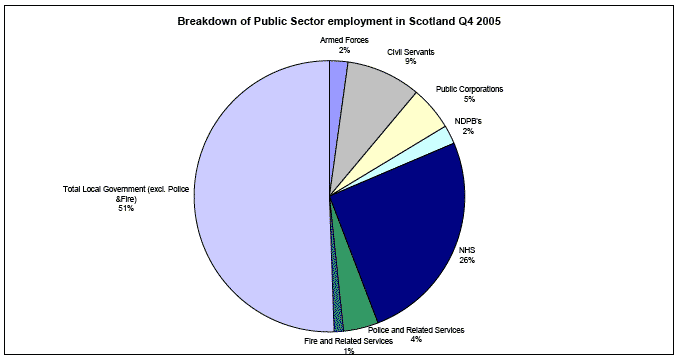
Source: Quarterly Public Sector Employment Series, Scottish Executive
Publication
Quarterly Public Sector Employment in Scotland - Q4 2005 (Published 2006)
Earnings
In 2005 the median gross annual full time income in Scotland was £21,400, up from £20,610 in 2004. However earnings differ considerably by type of occupation. "Managers and Senior Officials" and "Professional Occupations" have the highest median full time earnings at £31,334 and £31,062 respectively. The occupation group with the lowest median full time earnings is the "Sales and Customer Service Occupations" group at just £13,167. All occupation groups saw an increase in earnings between 2004 and 2005, however it should be noted that this does not take account of cost of living increases.
In 2005 Scotland was ranked 8 th out of the GB regions in terms of median full time earnings. The highest earnings were in London at £29,841 and the lowest were in the North East at £20,346.
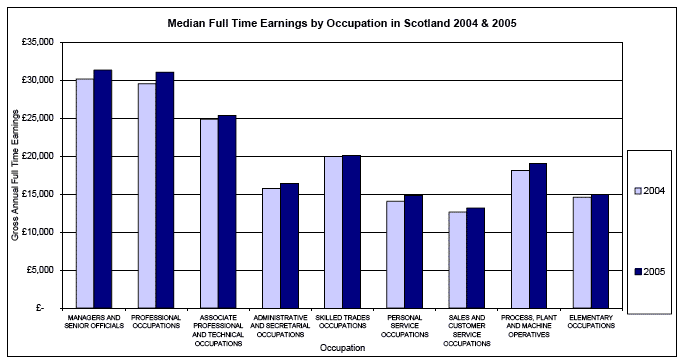
Source: Annual Survey of Hours and Earnings, Office for National Statistics
Publication
Annual Survey of Hours and Earnings Office for National Statistics (Published 2006)
People Claiming Worklessness Benefits
The number of people claiming workless benefits (unemployment benefits, incapacity benefit and income support) in Scotland was approximately 473,000 in November 2005. This is a reduction of over 17,800 since the same period in 2004.
Within Glasgow there are over 90,000 people claiming workless benefits which accounts for almost 20% of all workless benefits claimants in Scotland. However this is down from over 96,000 people claiming workless benefits in Glasgow in 2004. North Lanarkshire is the Local Authority area with the second largest amount of benefits claimants at 38,400 which is down from 40,500 in 2004. All but one Local Authority area saw a reduction in people claiming workless benefits between 2003 and 2005. Shetland was the only area to see an increase with the number of people claiming workless benefits increasing by less than 50.
Reducing the number of people claiming workless benefits within Glasgow, North & South Lanarkshire, Renfrewshire, Inverclyde, Dundee and West Dunbartonshire is one of the Closing the Opportunity Gap targets. The number of people claiming workless benefits in these areas has reduced by 10,500 between November 2004 and November 2005.
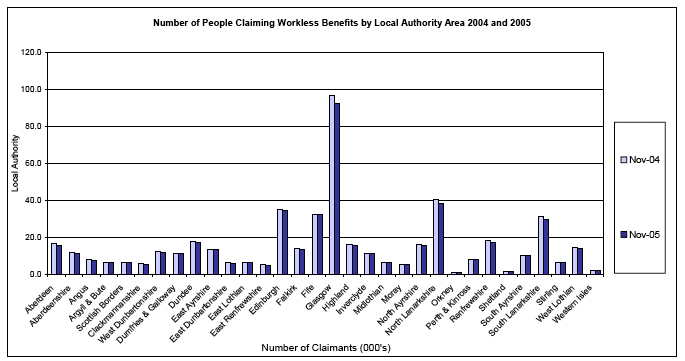
Source: Department for Work and Pensions
Web link
Closing the opportunity Gap Target A
16-19 Year Old not in Employment, Education or Training
The Number of 16-19 year olds Not in Employment, Education or Training ( NEET) was approximately 35,000 in 2004 which equates to 13.2% of the 16-19 year old population. The proportion NEET in Scotland has not significantly changed in any year since 1996 with the proportion fluctuating between 13% and 15%. Males generally have a higher proportion of NEET than Females.
Reducing the proportion of 16-19 year olds Not in Employment, Education or Training is one of the Closing the Opportunity Gap targets.
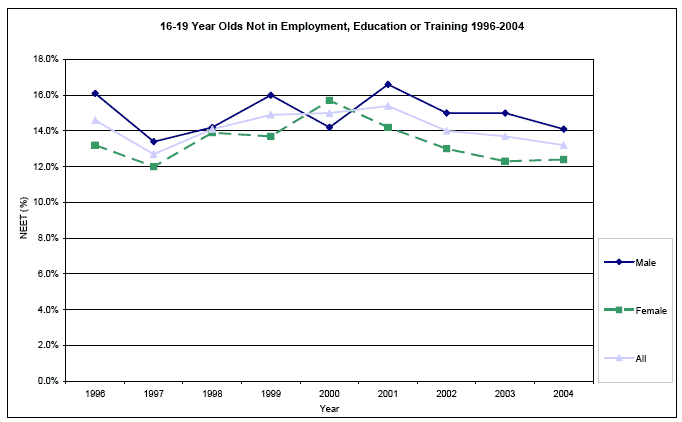
Source: Labour Force Survey ( LFS), Quarters combined for 1998-2002. The 2003 figures are taken from the Annual Scottish LFS ( ASLFS). The 2004 figures are taken from the APS. The APS and ASLFS include boosts to the main LFS. This means there is a discontinuity in the series.
Web link
Closing the Opportunity Gap Target B
There is a problem
Thanks for your feedback